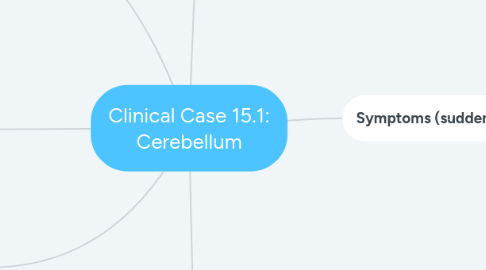
1. Past Medical History (PMH)
1.1. Hypertension
2. Other Possible Causes
2.1. Lesion in area besides cerebellum
2.1.1. Would also cause hemiparesis
2.1.2. Would also cause brainstem problems
2.2. PICA Cerebellar infarct
2.2.1. Ipsilateral ataxia WITH brainstem signs
3. Clinical Localization of Lesion
3.1. L Cerebellar hemisphere and vermis
3.2. L Superior, inferior, or middle cerebellar peduncle
4. Patient
4.1. 70-year-old
4.2. Male
4.3. Janitor
4.3.1. semi-retired
5. Symptoms (sudden onset)
5.1. Nausea/Vomiting
5.1.1. POSSIBLE CAUSES
5.1.1.1. Cerebellar vestibular involvement
5.1.1.2. Cerebellar lesion
5.2. Unsteadiness
5.2.1. Falling to L ( with eyes open AND closed)
5.2.1.1. L Arm and Leg ataxia (ipsilateral appendicular ataxia)
5.2.1.1.1. POSSIBLE CAUSES
5.2.1.1.2. Lateral motor systems
5.2.1.1.3. Irregular, uncoordinated movement
5.2.1.2. Truncal ataxia
5.2.1.2.1. Lesion near midline (vermis)
5.2.1.2.2. usually bilateral symptoms but fall towards side of lesion (L)
5.3. Mildly slurred speech
5.3.1. POSSIBLE CAUSES
5.3.1.1. Cerebellar lesion
5.4. L Dysmetria
5.4.1. Abnormal trajectories
5.4.1.1. testing
5.4.1.1.1. finger-to-nose
5.4.1.1.2. heel-to-shin
5.4.2. POSSIBLE CAUSE
5.4.2.1. Appendicular Ataxia
5.4.2.1.1. Cerebellar lesion on L side
5.5. L Dysdiadochokinesia
5.5.1. Abnormal rapid alternating movements (RAM)
5.6. Ataxia
5.6.1. Acute in adults
5.6.1.1. most common cause
5.6.1.1.1. toxins
5.6.1.1.2. stroke
6. Diagnosis
6.1. L Cerebellar infarct
6.1.1. Superior Cerebellar Artery (SCA)
6.1.1.1. Lateral hemispheres
6.1.1.1.1. motor planning for extremities
6.1.1.2. Intermediate hemispheres
6.1.1.2.1. Distal limb coordination
6.1.1.3. Because truncal AND appendicular ataxia
6.1.2. Could involve L Cerebellar peduncle

